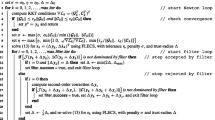Abstract
Numerous hierarchical and nonhierarchical decomposition strategies for the optimization of large scale systems, comprised of interacting subsystems, have been proposed. With a few exceptions, all of these strategies are essentially heuristic in nature. Recent work considered a class of optimization problems, called quasiseparable, narrow enough for a rigorous decomposition theory, yet general enough to encompass many large scale engineering design problems. The subsystems for these problems involve local design variables and global system variables, but no variables from other subsystems. The objective function is a sum of a global system criterion and the subsystems’ criteria. The essential idea is to give each subsystem a budget and global system variable values, and then ask the subsystems to independently maximize their constraint margins. Using these constraint margins, a system optimization then adjusts the values of the system variables and subsystem budgets. The subsystem margin problems are totally independent, always feasible, and could even be done asynchronously in a parallel computing context. An important detail is that the subsystem tasks, in practice, would be to construct response surface approximations to the constraint margin functions, and the system level optimization would use these margin surrogate functions. The present paper extends the quasiseparable necessary conditions for continuous variables to include discrete subsystem variables, although the continuous necessary and sufficient conditions do not extend to include integer variables.
Similar content being viewed by others
References
Alexandrov NM (1997) Multilevel methods for MDO. In: Alexandrov NM and Hussaini MY (eds.), Multidisciplinary design optimization. SIAM, Philadelphia, PA, pp. 79–89
Balabanov VO, Giunta AA, Golovidov O, Grossman B, Mason WH, Watson LT, Haftka RT (1999) Reasonable design space approach to response surface approximation. J Aircraft 36:308–315
Bloebaum CL, Hajela P, Sobieszczanski-Sobieski J (1990) Nonhierarchic system decomposition in structural optimization. In: Third NASA/Air Force Symp. on Recent Advances in Multidisciplinary Analysis and Optimization San Francisco, CA.
Dantzig GB, Wolfe P (1960) The decomposition principle for linear programs. Operations Research 8:101–111
Giunta AA, Balabanov V, Haim D, Grossman B, Mason WH, Watson LT, Haftka RT (1997a) Multidisciplinary optimisation of a supersonic transport using design of experiments theory and response surface modelling. Aeronautical J 101(1008):347–356
Giunta AA, Balabanov V, Kaufman M, Burgee S, Grossman B, Haftka RT, Mason WH, Watson LT (1997b) Variable-complexity response surface design of an HSCT configuration. In: Alexandrov N.M. and Hussaini M.Y. (eds.), Multidisciplinary design optimization. SIAM, Philadelphia, PA, pp. 348–367
Haftka RT, Watson LT (2005) Multidisciplinary design optimization with quasiseparable subsystems. Optim Engrg 6:9–20
Harte AM, McNamara JF, Roddy JD (2004) A multilevel approach to the optimisation of a composite light rail vehicle body shell. Composite Structures 63(3–4):447–453
Hosder S, Watson LT, Grossman B, Mason WH, Kim H, Haftka RT, Cox S (2001) Polynomial response surface approximations for the multidisciplinary design optimization of a high speed civil transport. Optim Engrg 2:431–452
Kroo I (1997) MDO for large-scale design. In: Alexandrov N.M. and Hussaini M.Y. (eds.), Multidisciplinary design optimization. SIAM, Philadelphia, PA, pp. 22–44
Liu B, Haftka RT (2004) Single-level composite wing optimization based on flexural lamination parameters. Structural Multidisciplinary Optimization 26(1/2):111–120
Liu B, Haftka RT, Akgün MA (2004) Two-level composite wing structural optimization using response surfaces. Structural Optimization 20(2):87–96
Liu B, Haftka RT, Watson LT (2004) Global-local structural optimization using response surfaces of local optimization margins. Structural Multidisciplinary Optimization 27:352–359
Ragon SA, Gürdal Z, Haftka RT, Tzong TJ (2003) Bilevel design of a wing structure using response surfaces. J Aircraft 40(5):985–992
Rodríguez JF, Renaud JE, Watson LT (1998a) Trust region augmented Lagrangian methods for sequential response surface approximation and optimization. ASME J Mech Design 120:58–66
Rodríguez JF, Renaud JE, Watson LT (1998b) Convergence of trust region augmented Lagrangian methods using variable fidelity approximation data. Structural Optim 15:141–156
Schutte J, Haftka RT, Watson LT (2004) Decomposition and two-level optimization of structures with discrete sizing variables. In: Proc. AIAA/ASME/ASCE/AHS/ASC 45th Structures, Structural Dynamics, and Materials Conf. AIAA Paper 2004–1541, Palm Springs, CA.
Shankar J, Ribbens CJ, Haftka RT, Watson LT (1993) Computational study of a nonhierarchial decomposition algorithm. Comput Optim Appl 2:273–293
Sobieszczanski-Sobieski J (1998) Optimization by decomposition: A step from hierarchic to nonhierarchic systems. In: Second NASA/Air force Symp. on Recent Advances in Multidisciplinary Analysis and Optimization Hampton, VA.
Wujek BA, Renaud JE, Batill SM (1997) A concurrent engineering approach for multidisciplinary design in a distributed computing environment. In: Alexandrov NM and Hussaini MY (eds.), Multidisciplinary Design Optimization. SIAM, Philadelphia, PA, pp. 189–208
Author information
Authors and Affiliations
Corresponding author
Rights and permissions
About this article
Cite this article
Haftka, R.T., Watson, L.T. Decomposition theory for multidisciplinary design optimization problems with mixed integer quasiseparable subsystems. Optim Eng 7, 135–149 (2006). https://doi.org/10.1007/s11081-006-6836-2
Received:
Revised:
Issue Date:
DOI: https://doi.org/10.1007/s11081-006-6836-2




